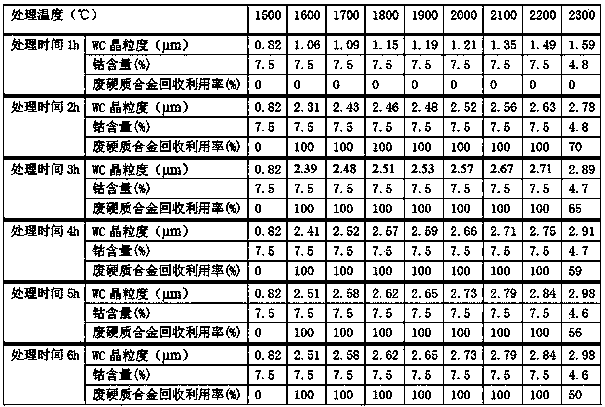Recovery method for waste hard alloy and application
A technology of cemented carbide and recycling method, applied in the field of powder metallurgy, can solve the problems of ineffective and in-depth utilization, uneven quality of recycled alloys, reduced alloy recycling rate, etc., and achieves easy operation and energy loss. Small, high recovery effect
- Summary
- Abstract
- Description
- Claims
- Application Information
AI Technical Summary
Problems solved by technology
Method used
Image
Examples
Embodiment 1
[0030] Mix the cemented carbides with serial numbers 1, 2, and 3 according to the mass ratio of 5:4:1 to obtain mixed waste cemented carbides, put them in an intermediate frequency furnace, and treat them at a high temperature of 1600°C for 4 hours. The average grain size of WC is 3.26μm, and the cobalt content is 12.75%.
Embodiment 2
[0032] Put the waste cemented carbide of No. 1 into an intermediate frequency furnace and treat it at a high temperature of 2200 ° C for 2 hours. After testing, the average WC grain size of the alloy is 2.63 μm, and the cobalt content is 7.5%.
Embodiment 3
[0034] Put the waste cemented carbide No. 2 into a carbonization furnace and treat it at a high temperature of 2200 ° C for 5 hours. After testing, the average WC grain size of the alloy is 3.05 μm, and the cobalt content is 18%.
PUM
| Property | Measurement | Unit |
|---|---|---|
| crystal size | aaaaa | aaaaa |
| crystal size | aaaaa | aaaaa |
| crystal size | aaaaa | aaaaa |
Abstract
Description
Claims
Application Information
 Login to View More
Login to View More - R&D
- Intellectual Property
- Life Sciences
- Materials
- Tech Scout
- Unparalleled Data Quality
- Higher Quality Content
- 60% Fewer Hallucinations
Browse by: Latest US Patents, China's latest patents, Technical Efficacy Thesaurus, Application Domain, Technology Topic, Popular Technical Reports.
© 2025 PatSnap. All rights reserved.Legal|Privacy policy|Modern Slavery Act Transparency Statement|Sitemap|About US| Contact US: help@patsnap.com



